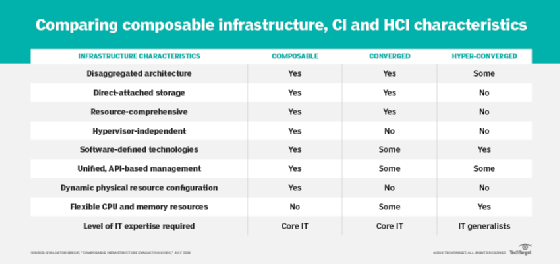
DrHitch - Fotolia
Words to go: Composable disaggregated infrastructure glossary
Dig into these terms to get a sense of composable infrastructure and what its disaggregated server capabilities can bring to your IT environment and application workloads.
You've heard about converged infrastructure and hyper-converged infrastructure. But has composable disaggregated infrastructure crossed your radar yet? If not, it probably will sooner rather than later.
Many consider composable infrastructure the next phase in the evolution of data center convergence. It aims to combine the simplicity of deploying, managing and scaling of hyper-converged infrastructure with CI-like rack-scale compute environments.
Composable infrastructure does this by employing concepts such as disaggregation and programmatic control to logically pool compute, storage and network fabric resources across a data center using software-defined techniques. These pooled IT resources are then shared as services that admins can draw upon through a composer and central controller to dynamically compose -- or create -- on-demand compute instances for specific uses and workloads. No hardware configuration is required.
The glossary below includes key terms you should know more about as you investigate whether composable disaggregated infrastructure is right for your organization.
Editor's note: We will follow this composable infrastructure glossary primer up with one that highlights some of the major vendors and products putting composable concepts into practice.
Disaggregation. This is the process by which the aggregated resources -- compute, storage, RAM, etc. -- from a server are pooled with resources from other servers in the data center for shared use by an application or workload. A software layer determines how much of each resource is available from each individual server for pooling.
Programmatic control. A key aspect to composable architecture is it enables users to program how disaggregated resources will be used, managed, configured and deployed for applications that draw on those resources. It does this through APIs that convert infrastructure into code for programmatic provisioning and deprovisioning.
Composer. All resources in composable disaggregated infrastructure are software-defined. The composer is the centralized software that handles all control plane activities for disaggregating server resources in the infrastructure. It abstracts them into an aggregated pool of discrete storage, compute and network resources that can be composed for customized use by applications.
Controller. A central controller manages the actual hardware, or data plane, in a composable infrastructure. It is the controller that works hand in hand with the composer to enable admins to dynamically compose servers on demand.
The controller does this by offering the programmable interface for assembling compute, storage and networking into customized platforms -- container, virtual machine or bare-metal server -- to run specific workloads. Templates defined by admins determine the optimal amount of shared resources to assemble and the best location to run these workloads.
Because the composer and controller work so closely together, composable infrastructure product vendors may conflate the terms or use them interchangeably. They may use just one term to describe the whole process of programmatically disaggregating and aggregating resources.

Infrastructure as code. Although composable infrastructure is sometimes referred to as infrastructure as code (IAC), they are not always synonymous. Stand-alone products Ansible and Chef, for example, are not composable infrastructure, but offer IAC capabilities.
All IAC and composable infrastructure enable the assembly and reassembly of racks of IT resources that have been logically pooled and presented as services for various workloads using software-defined techniques. The purpose is to simplify and automate infrastructure deployment using preprogrammed scripts. The composer and/or controller serves as the IAC system in composable disaggregated infrastructure.
Software-defined data center. Composed infrastructure brings enterprises closer to achieving the software-defined data center (SDDC). An SDDC uses software intelligence to virtualize server resources, as well as deploy, operate, provision, configure and deliver these elements as a service.
Unifying API. The unifying API in composable infrastructure systems is what enables the composer and controller to do their jobs. As hyper-converged infrastructure virtualizes and manages resources with the hypervisor, the unifying API manages resource disaggregation and the shared IT resource pool. It is also what lets you create preprogrammed scripts or templates to automate the deployment of infrastructure on demand.






